The world is an open gallery, a museum, a collection of beautiful landscapes, flora and fauna, and, to some extent, man-made creations as well. The world monuments are not just destinations; they are the elements that chain us to the past and remind us of our shared heritage and culture. These monuments remind us of our shared peace, brotherhood, and their importance. While the Statue of Liberty and Bodh Gaya act as a ‘token of peace and brotherhood,’ museums like the Auschwitz camp remind us of the bloody consequences of losing this ‘peace and brotherhood.’
Join me in this expedition to explore 12 man-made beauties that adorn the globe.
This wonderful blog features amazing examples of creativity and intelligence! You may want to write down your top choices with a pen and paper!
1. Statue of Liberty

The statue of a classically draped woman with a torch in the right hand raised above the head and a Tabula Anasta in the left hand. Yes, yes, you guessed it right, it’s the Statue of Liberty! Designed by the French sculptor Frédéric-Auguste Bartholdi and built by the famous Gustave Eiffel, it was a gift to the USA by the people of France to commemorate the alliance between France and the United States during the American Revolution. The statue likely resembles the Roman Goddess of Liberty, Libertas.
This man-made beauty symbolizes freedom, democracy, and opportunity. The table in the left hand suggests law, while the torch in the right hand suggests freedom, and the broken chain at her feet symbolizes the abolition of slavery. The statue is 305 feet tall and was originally covered in copper sheets, which were later oxidized to give it a green color.
This must-see attraction in New York City will give you an opportunity to experience the history of the land and its people, French architecture, and beautiful landscapes.
check out this blog : 11 Incredible World Heritage Sites in India that caught the eyes of the UNESCO!
2. Angkor wat
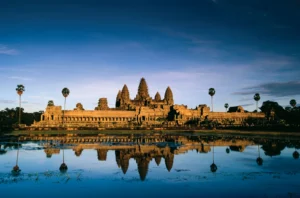
Originally constructed as a Hindu temple dedicated to Lord Vishnu in 1150 CE, the temple was gradually turned into a Buddhist temple. Located in the ancient Khmer capital city of Angkor, the temple premises are divided into two parts, namely the temple mountain and the galleried temple. The name Angkor Wat literally means ‘the city of Temple’ in the Khmer language. Commissioned by the Khmer ruler Suryavarman II in the 12th century, the construction of the temple occurred between 1122 and 1150 CE. A UNESCO World Heritage Site, located in Cambodia, it is a prime example of Khmer architecture and is considered the largest religious structure in the world by the Guinness World Record.
The temple’s design showcases perfect symmetry, while the walls are adorned with elaborate carvings depicting mythological scenes. The natural setting of the temples makes the visuals more breathtaking!
3. Easter island

Easter Island is an island and a special territory in Chile famous for almost 900 stone statues, moai, made by the early Rapa Nui people. The iconic giant figures on the island’s rugged terrain revel in the architecture marvel of the time. The surrounding area of the island features volcanic craters, caves, and rock formations, making the visitor experience even more breathtaking.
The island does not limit itself to the beauty of these statues. The history of the mysterious Rapa Nui civilization, which was present here on the island centuries ago, who built these Moai during the 1600 AD. The statues are ranging from 2 to 30 feet tall and are believed to be of their chiefs and descendants. This mystique
4. Leaning Tower of Pisa
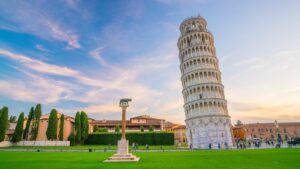
The Leaning Tower of Pisa is one of the three main structures in Pisa’s Cathedral Square, the other two being the cathedral and Pisa Baptistry. The uncommon thing about this bell tower is that it is a leaning one, and it took almost 199 years to fully construct. It started leaning in the 12th century during its course of construction due to the soft ground. The construction was completed in the 14th century; however, stabilization work was conducted in the 1990s to support the tower.
185 feet in height, it is made up of white marble and has eight stories, including the chamber for the bells. If you are in this Italy, this monument of heritage might grab your attention more than any other due to its unique feature.
Fact: even with the leaning condition, soft ground, and no support, the tower has survived almost 4 heavy earthquakes!
5. Sydney Opera House
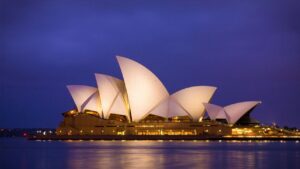
The Sydney Opera House in Sydney, Australia, is a center for performing arts, a prestigious venue for hosting galas, shows, concerts, or operas with a rich history of showcasing legendary performances! The best part of it is that it is easily accessible by public transportation or even walking! It took about 14 years to take the shape of Utzon’s vision and hosts almost 40 performances every week. The building of the opera is a magnificent one, a combination of natural and architectural elements (the bold curvaceous designs, the sail-like roof).
A place to sit and enjoy various performances, there are guided tours available for the tourists to access in order to gain a better outlook of this monument. A marvel of architecture and performing arts, this beauty will blow your mind!
6. Osaka Castle
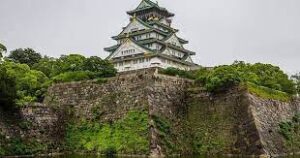
This castle is one of Japan’s most famous landmarks, and it was built by Hideyoshi Toyotomi, known as the ‘Napoleon of Japan.’ Osaka Castle is surrounded by 106 hectares of open park (the Osaka Castle Park) and has a 5-story main tower and an 8-story outer tower. In 1868 it was damaged during the Boshin War, a civil war, and later in 1931, it was restored.
The building is a unique blend of Japanese and Western architectural styles and has a museum and an observation deck to showcase the history. Spring is the best season to visit this castle when the cherry blossoms are at their peak. The green building really stands out in the pink surroundings!
7. Auschwitz concentration camp

The Auschwitz Concentration Camp Museum, also known as the Auschwitz-Birkenau State Museum, is located at the site of the former Auschwitz concentration camp in Oświęcim, Poland. The Auschwitz camp was the largest concentration camp of the Nazis, consisting of Auschwitz I, the original camp; Auschwitz II-Birkenau, an extermination camp; and Auschwitz III-Monowitz, a labor camp.
Now turned into a museum, this place will take you to the times of World War II, to the times of German Nazis and the cruelty played upon the Jews. It was recorded that more than 1 million Jews were killed in the Auschwitz concentration camp only! Time travel into the era where humanity lost its essence, and it will remind us to be grateful, kind, and respectful of what we have.
8. Bodh Gaya

A UNESCO World Heritage Site in the small town of Gaya, Bihar, in India. Bodh Gaya is the place where Siddharth Gautama attained enlightenment under the Bodhi tree in 563 BCE and became Gautam Buddha. Bodh Gaya has been a major pilgrimage site for the followers of Buddhism for almost 2,000 years, attracting pilgrims from all over the world. The influence of the various dynasties can be seen here, including the Mauryan, the Guptas, and even foreign dynasties such as the Chinese, Tibetans, etc.
The Mahabodhi Temple, the Bodhi Tree, the Great Buddha Statue, the Tibetan Monasteries, and the Archaeological Museum are some of the famous attractions of this historical place.
9. Mount Rushmore

Mount Rushmore, situated in the Black Hills of South Dakota, USA, is not only a breathtaking monument but also a testament to American history and democracy. Admired for its grandeur and the impressive scale of the sculptures, the beauty of Mount Rushmore is a dramatic blend of natural and man-made. It symbolizes the ideals and values associated with the four presidents depicted, namely George Washington, Thomas Jefferson, Theodore Roosevelt, and Abraham Lincoln.
The surrounding natural beauty of the Black Hills further enhances the overall experience, making it a powerful and evocative site for many visitors.
10. Petra
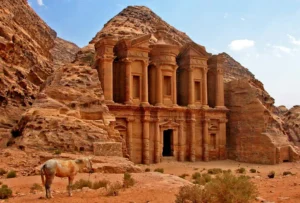
Established in the 6th century BCE by a nomadic Arabian tribe, the Nabataeans, this ancient city in Jordan is absolutely breathtaking! A destination of historical significance, it was annexed by the Roman Empire in 106 CE and later by the Byzantine Empire. Unfortunately, this city was abandoned by the 4th century CE and remained undiscovered until 1812, when a Swiss explorer, Johann Ludwig, rediscovered it.
This architectural marvel consists of the Treasury (Al-Khazneh), Monastery, Little Petra, the royal tombs, and even an amphitheater! A timeless symbol of human creativity, this abandoned beauty should not be abandoned by you!
11. Cologne Cathedral

The Cologne Cathedral, located in Cologne, Germany, is a prime example of Gothic architecture, with its intricate facades, soaring spires, and detailed stone carvings. The twin towers, each of 157 meters in height, are sky-touching and are one of the tallest in the world. The church took over 600 years to complete and is visible from almost every corner of the city!
The pilgrimage is believed to be one of the most important pilgrimages in Europe for the presence of the relics of the Three Magi. The church is now an important site of ecclesiastical art due to the presence of the remains of the three wise men. The building is a marvel, an architectural beauty, and is strong-rooted, having survived the bombing of World War II. The beauty and the history of this place will keep you swooned!
12. The Forbidden City

A UNESCO World Heritage Site, this served as the imperial palace for almost 24 emperors of the Ming and Qing dynasties. It is the largest palace complex in the world, covering over 180 acres with more than 980 buildings and 8,700 rooms. It was named the forbidden city, for it was limited to royalty only. The public was forbidden to enter the premises.
The palace complex is a vibrant one with lots of colors, the most striking one being yellow of the roof and red of the walls, contrasting to the lush green environment.
A masterpiece of Chinese traditional architecture, it’s a symbol of China’s imperial past and offers insights into the artistry, craftsmanship, and traditions of the era. The Forbidden City houses a vast collection of ancient artifacts, including paintings, ceramics, and calligraphy.
CONCLUSION
The beauty of world monuments lies in their intricate design, historical significance, and the cultural narratives they embody. From the grandeur of Mount Rushmore and the architectural splendor of the Forbidden City to the Gothic majesty of Cologne Cathedral, these landmarks offer more than just visual appeal—they provide a profound connection to the past and a deeper understanding of different cultures and histories.
